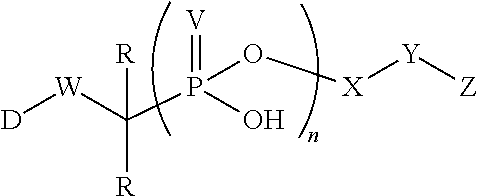Phosponate linkers and their use to facilitate cellular retention of compounds
a technology of phosphonate linkers and compounds, applied in the field of phosphonate linkers and their use to facilitate intracellular retention of compounds, can solve the problems of drug use, drug composition, and drug use, and achieve the effect of promoting the conjugation of antibodies and drugs
- Summary
- Abstract
- Description
- Claims
- Application Information
AI Technical Summary
Benefits of technology
Problems solved by technology
Method used
Image
Examples
example 1
[0225]This example shows the synthesis of the C21 Analogs.
[0226]Preparation of C21 Analog (10-(((6S,8S,9R,10S,11S,13S,14S,16R,17R)-6,9-difluoro-11-hydroxy-10,13,16-trimethyl-3-oxo-17-(propionyloxy)-6,7,8,9,10,11,12,13,14,15,16,17-dodecahydro-3H-cyclopenta[a]phenanthrene-17-carbonyl)thio)decyl)phosphonic acid (3) was as follows.
[0227]In a dry round bottom flask equipped with a stir bar under nitrogen, (6S,8S,9R,10S,11S,13S,14S,16R,17R)-6,9-difluoro-11-hydroxy-10,13,16-trimethyl-3-oxo-17-(propionyl-oxy)-6,7,8,9,10,11,12,13,14,15,16,17-dodecahydro-3H cyclopenta[a] phenanthrene-17-carbothioic S-acid (1, 200 mg, 0.427 mmol) and (10-bromodecyl)phosphonic acid (2, 141 mg, 0.470 mmol, 1.10 eq.) were dissolved in anhydrous DMF (2.1 mL, 0.2M). After 10 minutes of stirring, diisopropylethylamine (176 μL, 1.07 mmol, 2.50 eq.) was added and the reaction stirred overnight at ambient temperature. Upon completion as determined by LCMS, the reaction was concentrated, diluted in DMSO and directly inj...
example 2
[0228]This example shows the synthesis of the C17 Analogs.
[0229]Preparation of C17 Analog (9-(((6S,8S,9R,10S,11S,13S,14S,16R,17R)-6,9-difluoro-17-(((fluoromethypthio)carbonyl)-11-hydroxy-10,13,16-trimethyl-3-oxo-6,7,8,9,10,11,12,13,14,15,16,17-dodecahydro-3H-cyclopenta[a]phenanthren-17-yl)oxy)-9-oxononyl)phosphonic acid (18) was follows
Step A: Preparation of (6S,8S,9R,10S,11S,13S,14S,16R,17R)-6,9-difluoro-11-hydroxy-10,13,16-trimethyl-17-(non-8-enoyloxy)-3-oxo-6,7,8,9,10,11,12,13,14,15,16,17-dodecahydro-3H-cyclopenta[a]phenanthrene-17-carbothioic S-Acid (16)
[0230]In a dry round bottom flask equipped with a stir bar under nitrogen, (6S,8S,9R,10S,11S,13S,14S,16R,17R)-6,9-difluoro-11,17-dihydroxy-10,13,16-trimethyl-3-oxo-6,7,8,9,10,11,12,13,14,15,16,17-dodecahydro-3H-cyclopenta[a]phenanthrene-17-carbothioic S-acid (15, 100 mg, 0.242 mmol) and triethylamine (84 μL, 0.606 mmol, 2.50 eq.) were dissolved in anhydrous DCM (12.0 mL, 0.02M). To this was added non-8-enoyl chloride (93 mg, 0.53...
example 3
[0234]This example shows the synthesis of intermediate 25 for constructing A-Ring Analogs.
[0235]Preparation of intermediate 2-((tert-butyldimethylsilyl)oxy)-1-((3aR,4aS,4bS,11aR,11bS,12S,13aS,13bS)-12-hydroxy-8-(4-hydroxyphenyl)-11a,13a-dimethyl-2-propyl-3a,4,4a,4b,5,6,8,11,11a,11b,12,13,13a,13b-tetradecahydro-[1,3]dioxolo[4″,5″:3′,4′]cyclopenta[1′,2′:5,6]naphtho[1,2-f]indazol-13b-yl)ethanone (23) was as follows.
Step A: Preparation of 4-((3aR,4aS,4bS,11aR,11bS,12S,13aS,13bS)-13b-(2-((tert-butyldimethylsilyl)oxy)acetyl)-12-hydroxy-11a,13a-dimethyl-2-propyl-4,4a,5,6,11,11a,11b,12,13,13a-decahydro-[1,3]dioxolo[4″,5″:3′,4′]cyclopenta[1′,2′:5,6]naphtho[1,2-f]indazol-8(3aH,4bH,13bH)-yl)phenyl pivalate (22)
[0236]In a dry 20 mL microwave vial equipped with a stir bar under nitrogen, (20, 500 mg, 0.870 mmol, synthesis described in WO 2009082342) and 4-hydrazinylphenyl pivalate HCl (21, 234 mg, 0.957 mmol, 1.10 eq.) were dissolved in ethanol (5.1 mL, 0.17M). To this was added potassium acetat...
PUM
 Login to View More
Login to View More Abstract
Description
Claims
Application Information
 Login to View More
Login to View More - R&D
- Intellectual Property
- Life Sciences
- Materials
- Tech Scout
- Unparalleled Data Quality
- Higher Quality Content
- 60% Fewer Hallucinations
Browse by: Latest US Patents, China's latest patents, Technical Efficacy Thesaurus, Application Domain, Technology Topic, Popular Technical Reports.
© 2025 PatSnap. All rights reserved.Legal|Privacy policy|Modern Slavery Act Transparency Statement|Sitemap|About US| Contact US: help@patsnap.com



